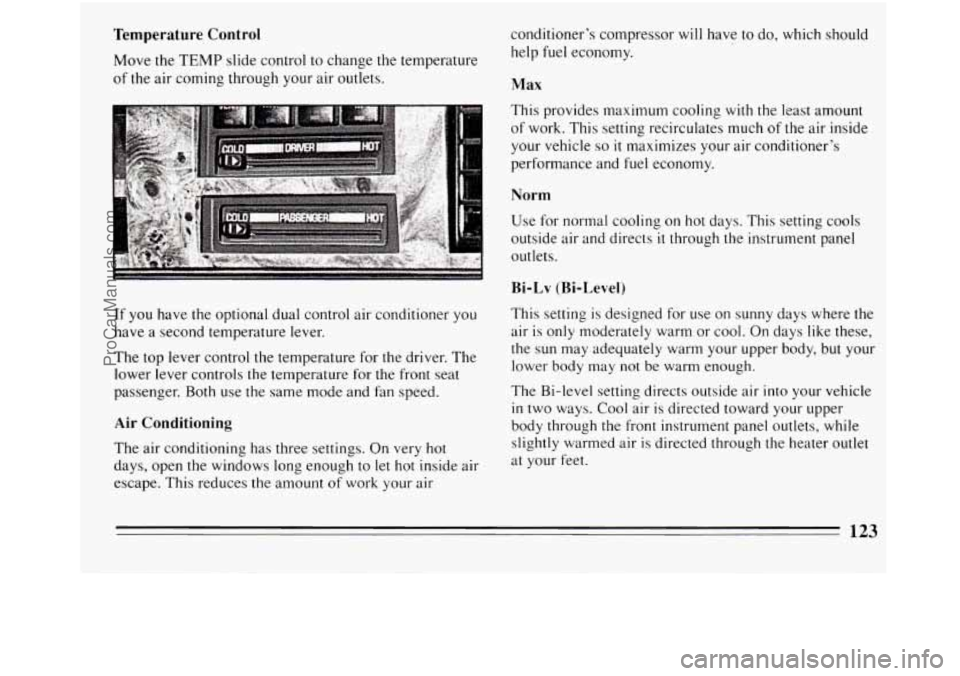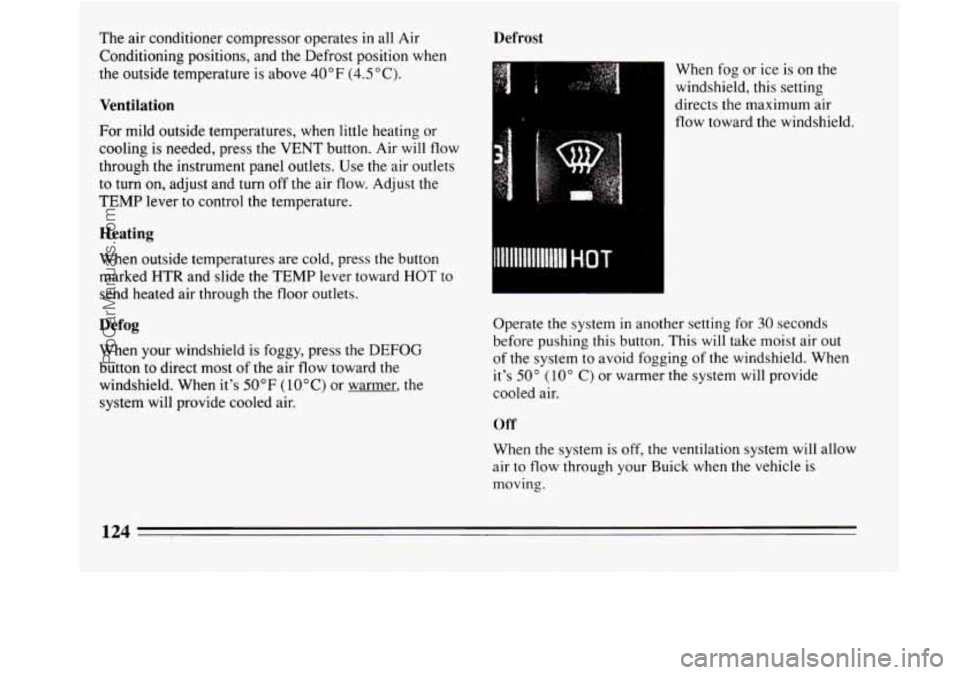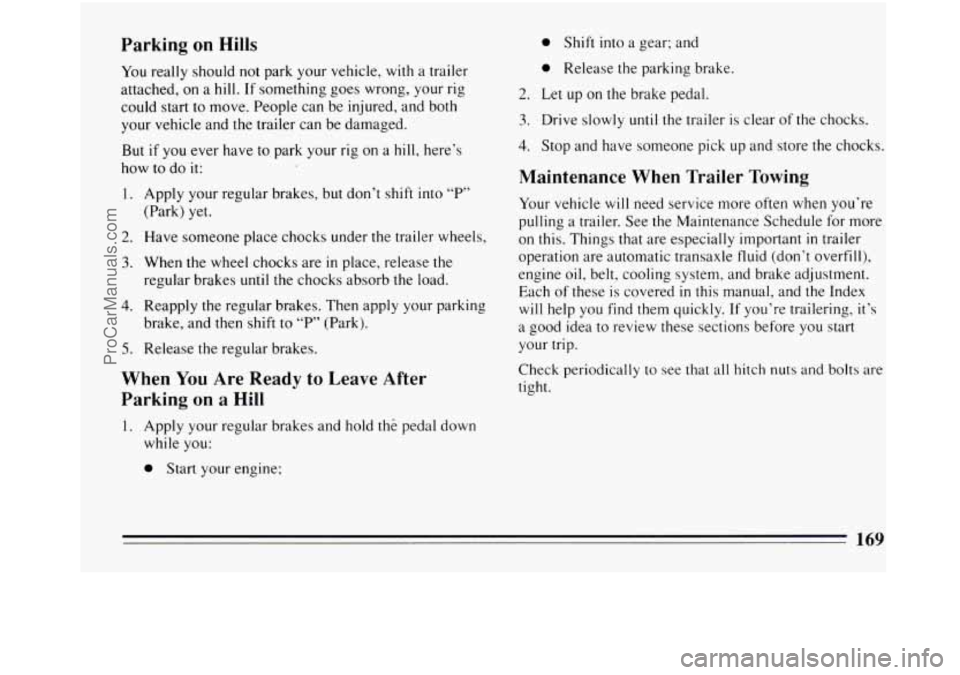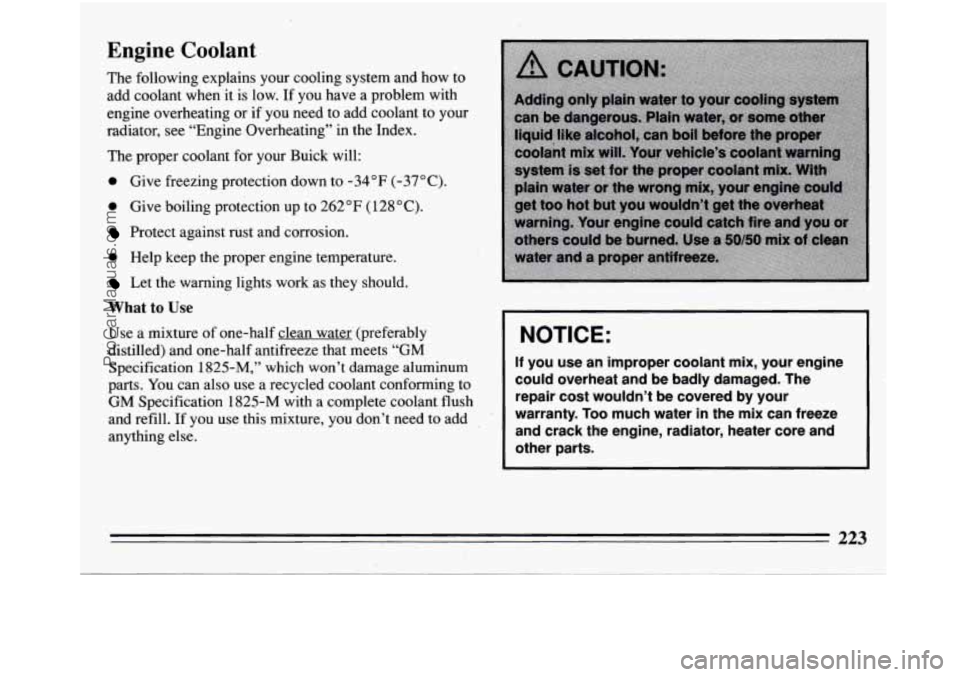Page 125 of 308

Temperature Control conditioner’s compressor will have to do, which should
Move the TEMP slide control to change the temperature
of the air coming through your air outlets. Max
help fuel economy.
If you have the optional dual control air conditioner you
have a second temperature lever.
The top lever control the temperature for the driver. The
lower lever controls the temperature for the front seat
passenger. Both use the same mode and fan speed.
Air Conditioning
The air conditioning has three settings. On very hot
days, open
the windows long enough to let hot inside air
escape. This reduces the amount of work your
air
This provides maximum cooling with the least amount
of work. This setting recirculates much of the air inside
your vehicle
so it maximizes your air conditioner’s
performance and fuel economy.
Norm
Use for normal cooling on hot days. This setting cools
outside air and directs
it through the instrument panel
outlets.
Bi-Lv (Bi-Level)
This setting is designed for use on sunny days where the
air is only moderately warm or cool.
On days like these,
the sun may adequately warm your upper body, but your
lower body may not be warm enough.
The Bi-level setting directs outside air into your vehicle
in two ways. Cool air is directed toward your upper
body through the front instrument panel outlets, while
slightly warmed air is directed through the heater outlet
at your feet.
123
ProCarManuals.com
Page 126 of 308

The air conditioner compressor operates in all Air
Conditioning positions, and the Defrost position when
the outside temperature is above
40°F (4.5"C).
Ventilation
For mild outside temperatures, when little heating or
cooling is needed, press the
VENT button. Air will flow
through the instrument panel outlets. Use the air outlets
to turn on, adjust and turn off the air flow. Adjust the
TEMP lever to control the temperature.
Heating
When outside temperatures are cold, press the button
marked HTR and slide the
TEMP lever toward HOT to
send heated air through the floor outlets.
Defog
When your windshield is foggy, press the DEFOG
button to direct most of the air flow toward the
windshield. When it's
50°F (IOOC) or warmer, the
system will provide cooled air.
Defrost
. When fog or ice is on the
windshield, this setting
directs the maximum air
flow toward the windshield.
Operate the system
in another setting for 30 seconds
before pushing this button. This
will take moist air out
of the system to avoid fogging
of the windshield. When
it's 50" (10" C) or warmer the system will provide
cooled air.
Off
When the system is off, the ventilation system will allow
air to flow through your Buick when the vehicle is
moving.
124
ProCarManuals.com
Page 161 of 308
Hill and Mountain Roads
I
Driving on steep hills or mountains is different from
driving
in flat or rolling terrain. If you
drive regularly in steep country, or
if you're
planning to visit there, here are some tips that can make
your trips safer and more enjoyable.
0 Keep your vehicle in good shape. Check all fluid
levels and
also the brakes, tires, cooling system and
transaxle. These parts can work hard on mountain
roads.
0 Know how to go down hills. The most important
thing to know is this: let your engine do some of the
slowing down. Shift to a lower gear when you go
down a steep or long
hill.
159
ProCarManuals.com
Page 171 of 308

Parking on Hills
You really should not park your vehicle, with a trailer
attached,
on a hill. If something goes wrong, your rig
could start to move. People can be injured, and both
your vehicle and the trailer can be damaged.
But
if you ever have to park your rig on a hill, here’s
how
to do it:
0 Shift into a gear; and
2. Have someone place chocks under the trailer wheels,
3. When the wheel chocks are in place, release the
regular brakes until the chocks absorb the load.
4. Reapply the regular brakes. Then apply your parking
brake, and
then shift to “P” (Park).
5. Release the regular brakes.
When You Are Ready to Leave After
Parking
on a Hill
0 Release the parking brake.
2. Let up on the brake pedal.
3. Drive slowly until the trailer is clear of the chocks.
4. Stop and have someone pick up and store the chocks.
Maintenance When Trailer Towing
Your vehicle will need service more often when you’re
pulling a trailer. See the Maintenance Schedule for more
on this. Things that are especially important
in trailer
operation are automatic transaxle fluid (don’t overfill),
engine oil, belt, cooling system, and brake adjustment.
Each of these is covered
in this manual, and the Index
will help you find them quickly. If you’re trailering, it’s
a good idea to review these sections before you start
your trip.
Check periodically to see that all hitch nuts and bolts are
tight.
1. Apply your regular brakes and hold the pedal down
while you:
0 Start your engine;
169
ProCarManuals.com
Page 191 of 308
If the coolant inside the coolant recovery tank is boiling,
don’t do anything else until it cools down. The coolant level should be
at or above the
“COLD’
mark. If it isn’t, you may have a leak in the radiator
hoses, heater hoses, radiator, water pump or somewhere
else in the cooling system.
I NOTICE:
I
Engine damage from running your engine
without
coolant isn’t covered by your warranty. I
If there seems to be no leak, check to see if the electric
engine fan is running.
If the engine is overheating, the
fan should be running.
If it isn’t, your vehicle needs
service.
ProCarManuals.com
Page 193 of 308
I A CAUTION:
You can be burned if you spill coolant on hot
engine parts. Coolant contains ethylene glycol
and
it will burn if the engine parts are hot
enough, Don’t spill coolant on a hot engine.
When the coolant in the coolant recovery tank is at or
above the
“COLD” mark, start your vehicle.
If the overheat warning continues, there’s one more
thing you can try.
You can add the proper coolant mix
directly to the radiator but be sure the cooling system is
cool before you do it.
A CAUTION:
Steam and scalding liquids from a hot cooling
system can blow out and
burn you badly. They
are under pressure,
and if you turn the radiator
pressure cap
-- even a fittle -- they can come out
at
high speed. Never turn the cap when the
cooling system, including the radiator pressure
cap, is
hot.
CAUTION: (Continued)
CAUTION: (Continued)
Wait for
the cooling system and radiator
pressure cap to cool
if you ever have to turn the
pressure cap.
d
I
191
ProCarManuals.com
Page 194 of 308
How to Add Coolant to the Radiator
NOTICE:
Your engine has a specific radiator fill procedure.
Failure to follow this procedure could cause your
engine to overheat and
be severely damaged.
. ..,
1. You can remove the
radiator pressure cap when
the
cooling system,
including the
radiator pressure
cap and upper
radiator hose, is no
longer hot.
2.
Turn the pressure cap slowly to the left until it first stops.
(Don’t press down while turning the pressure cap.)
If you hear a hiss, wait for that to stop.
A hiss means
there
is still some pressure left.
Then keep turning the pressure cap, but now push
down as you turn
it. Remove the pressure cap.
192
ProCarManuals.com
Page 225 of 308

Engine Coolant
The following explains your cooling system and how to
add coolant when it is low. If you have a problem with
engine overheating or if you need to add coolant to your
radiator, see “Engine Overheating” in the Index.
The proper coolant for your Buick will:
0 Give freezing protection down to -34°F (-37°C).
0 Give boiling protection up to 262°F (128°C).
Protect against rust and corrosion.
0 Help keep the proper engine temperature.
Let the warning lights work as they should.
What to Use
Use a mixture of one-half clean water (preferably
distilled) and one-half antifreeze that meets “GM Specification
1825-M,” which won’t damage aluminum
parts. You can also use a recycled coolant conforming to
GM Specification 1825-M with a complete coolant flush
and refill.
If you use this mixture, you don’t need to add
anything else.
NOTICE:
If you use an improper coolant mix, your engine
could overheat and be badly damaged. The repair cost wouldn’t be covered by your
warranty. Too much water in the mix can freeze
‘and crack the engine, radiator, heater core and other parts.
223
ProCarManuals.com